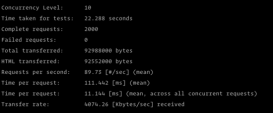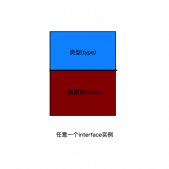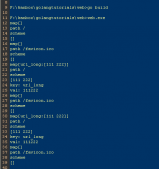1.簡介
Container — 容器數據類型:該包實現了三個復雜的數據結構:堆、鏈表、環
-
List:Go中對鏈表的實現,其中List:雙向鏈表,Element:鏈表中的元素 -
Ring:實現的是一個循環鏈表,也就是我們俗稱的環 -
Heap:Go中對堆的實現
2.list
簡單實用:
|
1
2
3
4
5
6
7
8
9
10
11
12
13
|
func main() { // 初始化雙向鏈表 l := list.New() // 鏈表頭插入 l.PushFront(1) // 鏈表尾插入 l.PushBack(2) l.PushFront(3) // 從頭開始遍歷 for head := l.Front();head != nil;head = head.Next() { fmt.Println(head.Value) }} |
方法列表:
|
1
2
3
4
5
6
7
8
9
10
11
12
13
14
15
16
17
18
19
20
21
|
type Element func (e *Element) Next() *Element // 返回該元素的下一個元素,如果沒有下一個元素則返回 nil func (e *Element) Prev() *Element // 返回該元素的前一個元素,如果沒有前一個元素則返回niltype List func New() *List // 返回一個初始化的list func (l *List) Back() *Element // 獲取list l的最后一個元素 func (l *List) Front() *Element // 獲取list l的第一個元素 func (l *List) Init() *List // list l 初始化或者清除 list l func (l *List) InsertAfter(v interface{}, mark *Element) *Element // 在 list l 中元素 mark 之后插入一個值為 v 的元素,并返回該元素,如果 mark 不是list中元素,則 list 不改變 func (l *List) InsertBefore(v interface{}, mark *Element) *Element // 在 list l 中元素 mark 之前插入一個值為 v 的元素,并返回該元素,如果 mark 不是list中元素,則 list 不改變 func (l *List) Len() int // 獲取 list l 的長度 func (l *List) MoveAfter(e, mark *Element) // 將元素 e 移動到元素 mark 之后,如果元素e 或者 mark 不屬于 list l,或者 e==mark,則 list l 不改變 func (l *List) MoveBefore(e, mark *Element) // 將元素 e 移動到元素 mark 之前,如果元素e 或者 mark 不屬于 list l,或者 e==mark,則 list l 不改變 func (l *List) MoveToBack(e *Element) // 將元素 e 移動到 list l 的末尾,如果 e 不屬于list l,則list不改變 func (l *List) MoveToFront(e *Element) // 將元素 e 移動到 list l 的首部,如果 e 不屬于list l,則list不改變 func (l *List) PushBack(v interface{}) *Element // 在 list l 的末尾插入值為 v 的元素,并返回該元素 func (l *List) PushBackList(other *List) // 在 list l 的尾部插入另外一個 list,其中l 和 other 可以相等 func (l *List) PushFront(v interface{}) *Element // 在 list l 的首部插入值為 v 的元素,并返回該元素 func (l *List) PushFrontList(other *List) // 在 list l 的首部插入另外一個 list,其中 l 和 other 可以相等 func (l *List) Remove(e *Element) interface{} // 如果元素 e 屬于list l,將其從 list 中刪除,并返回元素 e 的值 |
2.1數據結構
節點定義:
|
1
2
3
4
5
6
7
8
9
10
|
type Element struct { // 后繼指針,前向指針 next, prev *Element // 鏈表指針,屬于哪個鏈表 list *List // 節點value Value interface{}} |
雙向鏈表定義:
|
1
2
3
4
5
6
|
type List struct { // 根元素 root Element // sentinel list element, only &root, root.prev, and root.next are used // 實際節點數量 len int // current list length excluding (this) sentinel element} |
初始化:
|
1
2
3
4
5
6
7
8
9
|
// 通過工廠方法返回list指針func New() *List { return new(List).Init() }func (l *List) Init() *List { l.root.next = &l.root l.root.prev = &l.root l.len = 0 return l} |
這里可以看到root節點作為一個根節點,不承擔數據,也不是實際的鏈表節點,節點數量len沒算上它,再初始化的時候,root節點會成為一個只有一個節點的環(前后指針都指向自己)
2.2插入元素
頭插法:
|
1
2
3
4
5
6
7
8
9
10
11
|
func (l *List) Front() *Element { if l.len == 0 { return nil } return l.root.next}func (l *List) PushFront(v interface{}) *Element { l.lazyInit() return l.insertValue(v, &l.root)} |
尾插法:
|
1
2
3
4
5
6
7
8
9
10
11
|
func (l *List) Back() *Element { if l.len == 0 { return nil } return l.root.prev}func (l *List) PushBack(v interface{}) *Element { l.lazyInit() return l.insertValue(v, l.root.prev)} |
在指定元素后新增元素:
|
1
2
3
4
5
6
7
8
9
|
func (l *List) insert(e, at *Element) *Element { e.prev = at e.next = at.next e.prev.next = e e.next.prev = e e.list = l l.len++ return e} |
這里有個延遲初始化的邏輯:lazyInit,把初始化操作延后,僅在實際需要的時候才進行
|
1
2
3
4
5
|
func (l *List) lazyInit() { if l.root.next == nil { l.Init() }} |
移除元素:
|
1
2
3
4
5
6
7
8
9
10
|
// remove 從雙向鏈表中移除一個元素e,遞減鏈表的長度,返回該元素e func (l *List) remove(e *Element) *Element { e.prev.next = e.next e.next.prev = e.prev e.next = nil // 防止內存泄漏 e.prev = nil // 防止內存泄漏 e.list = nil l.len -- return e } |
3.ring
Go中提供的ring是一個雙向的循環鏈表,與list的區別在于沒有表頭和表尾,ring表頭和表尾相連,構成一個環
使用demo:
|
1
2
3
4
5
6
7
8
9
10
11
12
13
14
15
16
|
func main() { // 初始化3個元素的環,返回頭節點 r := ring.New(3) // 給環填充值 for i := 1;i <= 3;i++{ r.Value = i r = r.Next() } sum := 0 // 對環的每個元素進行處理 r.Do(func(i interface{}) { sum = i.(int) + sum }) fmt.Println(sum)} |
方法列表:
|
1
2
3
4
5
6
7
8
9
|
type Ring func New(n int) *Ring // 初始化環 func (r *Ring) Do(f func(interface{})) // 循環環進行操作 func (r *Ring) Len() int // 環長度 func (r *Ring) Link(s *Ring) *Ring // 連接兩個環 func (r *Ring) Move(n int) *Ring // 指針從當前元素開始向后移動或者向前(n 可以為負數) func (r *Ring) Next() *Ring // 當前元素的下個元素 func (r *Ring) Prev() *Ring // 當前元素的上個元素 func (r *Ring) Unlink(n int) *Ring // 從當前元素開始,刪除 n 個元素 |
3.1數據結構
環節點數據結構:
|
1
2
3
4
|
type Ring struct { next, prev *Ring // 前繼和后繼指針 Value interface{} // for use by client; untouched by this library} |
初始化一個環:后繼和前繼指針都指向自己
|
1
2
3
4
5
|
func (r *Ring) init() *Ring { r.next = r r.prev = r return r} |
初始化指定數量個節點的環
|
1
2
3
4
5
6
7
8
9
10
11
12
13
14
|
func New(n int) *Ring { if n <= 0 { return nil } r := new(Ring) p := r for i := 1; i < n; i++ { p.next = &Ring{prev: p} p = p.next } p.next = r r.prev = p return r} |
遍歷環,對個元素執行指定操作:
|
1
2
3
4
5
6
7
8
|
func (r *Ring) Do(f func(interface{})) { if r != nil { f(r.Value) for p := r.Next(); p != r; p = p.next { f(p.Value) } }} |
4.heap
Go中堆使用的數據結構是最小二叉樹,即根節點比左邊子樹和右邊子樹的所有值都小
使用demo:需要實現Interface接口,go中堆都是實現這個接口,定義了排序,插入和刪除方法
|
1
2
3
4
5
|
type Interface interface { sort.Interface Push(x interface{}) // add x as element Len() Pop() interface{} // remove and return element Len() - 1.} |
實現接口:
|
1
2
3
4
5
6
7
8
9
10
11
12
13
14
15
16
17
18
19
20
21
22
23
24
25
26
27
28
29
30
31
32
33
34
35
|
// An IntHeap is a min-heap of ints.type IntHeap []intfunc (h IntHeap) Len() int { return len(h) }func (h IntHeap) Less(i, j int) bool { return h[i] < h[j] }func (h IntHeap) Swap(i, j int) { h[i], h[j] = h[j], h[i] }func (h *IntHeap) Push(x interface{}) { // Push and Pop use pointer receivers because they modify the slice's length, // not just its contents. *h = append(*h, x.(int))}func (h *IntHeap) Pop() interface{} { old := *h n := len(old) x := old[n-1] *h = old[0 : n-1] return x}// This example inserts several ints into an IntHeap, checks the minimum,// and removes them in order of priority.func Example_intHeap() { h := &IntHeap{2, 1, 5} heap.Init(h) heap.Push(h, 3) fmt.Printf("minimum: %d\n", (*h)[0]) for h.Len() > 0 { fmt.Printf("%d ", heap.Pop(h)) } // Output: // minimum: 1 // 1 2 3 5} |
4.1數據結構
上浮:
|
1
2
3
4
5
6
7
8
9
10
11
12
13
14
15
|
func Push(h Interface, x interface{}) { h.Push(x) up(h, h.Len()-1)}func up(h Interface, j int) { for { i := (j - 1) / 2 // parent if i == j || !h.Less(j, i) { break } h.Swap(i, j) j = i }} |
下沉:
|
1
2
3
4
5
6
7
8
9
10
11
12
13
14
15
16
17
18
19
20
21
22
23
24
25
26
|
func Pop(h Interface) interface{} { n := h.Len() - 1 h.Swap(0, n) down(h, 0, n) return h.Pop()}func down(h Interface, i0, n int) bool { i := i0 for { j1 := 2*i + 1 if j1 >= n || j1 < 0 { // j1 < 0 after int overflow break } j := j1 // left child if j2 := j1 + 1; j2 < n && h.Less(j2, j1) { j = j2 // = 2*i + 2 // right child } if !h.Less(j, i) { break } h.Swap(i, j) i = j } return i > i0} |
到此這篇關于Go container包的介紹的文章就介紹到這了,更多相關Go container包內容請搜索服務器之家以前的文章或繼續瀏覽下面的相關文章希望大家以后多多支持服務器之家!
原文鏈接:https://blog.csdn.net/weixin_41922289/article/details/121592261












